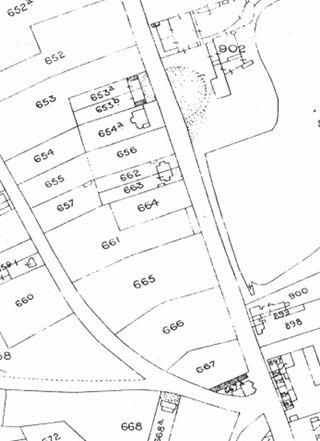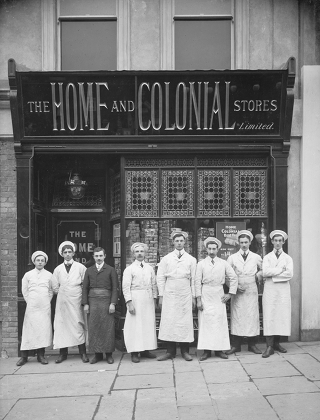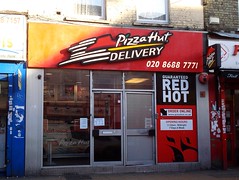Euro Fruiterers at 31 London Road may look modest, but this small shopfront has a venerable history in grocery sales. It's also one of the oldest buildings on this part of the road.
1840s–1850s: Setting the scene for development along London Road
Aside from the Old Fox & Hounds at number 1, all the buildings I’ve discussed so far along the west side of London Road started their lives as shops with accommodation above for the shopkeepers.[1] However, the four properties just south of Mead Place — numbers 31–37 — originated as purely private residences.[2] They were also among the earliest buildings on this part of London Road; the shops further south all came later.[3] Taken together, these facts suggest that the impetus for building numbers 31–37 came from the proximity of the railway, rather than commercial spread northwards from the town centre.

Before the railway came to West Croydon in 1839 — and for a few decades after — the land on both sides of London Road was mostly undeveloped.[4]
1844: The east side
On the east side of the road, the 1844 Tithe Award records a small cluster of houses and cottages on the land around the railway station. Further north were gardens, a meadow, and a large house, all owned by Richard Sterry, with the house lying just south of where Kidderminster Road is today. Between Richard Sterry’s house and St James’s Road was a large meadow owned by James Cox, with a small row of cottages at the edge running along St James’s Road itself.
1820s–1850s: The west side
The Fox & Hounds pub on the west side, opposite the station, had also been built by 1844, though it was then known as the Croydon Station Inn. Stretching north from here along the west side of London Road was a patchwork of meadow land and “building ground” owned by a dozen different people. This land had previously been an area of common land known as Parsons Mead, which was enclosed (i.e. passed into private hands) in the 1820s and then split up and sold in lots in 1835.[5]
Very few of these plots had been built on by the point when this area was surveyed for the Tithe Award; only six houses are listed. The area currently occupied by 79–87 London Road (i.e. the block containing Mazi and Beydagi, south of Lidl) contained a pair of houses owned and rented out by Henry Bance (these were demolished around 1898), the area currently occupied by Lidl and its car park had another three houses, and a large tract of land just south of Sumner Road was occupied by Jonathan Barrett’s house, garden, stable, and meadow.
Infill between the inn and Henry Bance’s houses was slow. Until numbers 31–57 were built in the mid-1850s, the west side of London Road was still all open land between the inn (by then known as the Fox & Hounds) and the building currently occupied by the Croydon Food Centre (number 59).[6]
1850s: Construction of numbers 31–57
The two blocks of houses comprising 31–57 London Road were built between 1853 and 1855 on land purchased in 1835 by Arthur Lewis (plot 665 on the Tithe Award map above).[8] Despite the present-day numbering (which has a gap between numbers 37 and 51, and shoehorns numbers 51 and 53 into a single shopfront and indeed a single business), these blocks contained only four and three houses respectively,[9] with the road which later became known as Mead Place running off westwards between them.[10]
1850s–1860s: James Janes, commercial traveller
The first occupant of number 31 that I’m aware of was James Janes, a commercial traveller in the cotton and linen trade, who had moved in by 1858. Somewhat confusingly, the London Gazette of 5 January 1864 reports that he was “adjudicated bankrupt the 21st day of May, 1863”; this doesn’t seem to have affected his residency on London Road, as he remained there until around 1871.[11]
1870s: William John Pease, watchmaker
The departure of James Janes and his family from London Road saw the transformation of number 31 from a private residence into a place of business — that of William John Pease, watchmaker. Mr Pease was in place by 1873, but gone again by 1876.[12]
1870s–1880s: William Gilbert, homoeopathic chemist, and John Culver, dentist
William Pease was replaced by William Gilbert, homoeopathic chemist, who by 1878 was in partnership with John Culver, a dentist. The partnership had two properties; this one on London Road and another on Commercial Road in Bournemouth. However, this partnership was dissolved in March 1881, with William Gilbert taking charge of the Bournemouth business and John Culver remaining in proprietorship of the Croydon side.
John continued to practice here until around 1890, when he moved first (and very briefly) to Tamworth Road and then to North End. While on North End he took on a new partner, Burt Sawday, and around 1914 the partnership returned to London Road — this time, to number 147.[13]
1890s–1900s: Fruit and vegetables
The two decades following John Culver’s departure from 31 London Road saw several periods of vacancy, interrupted by a few short-lived fruit and vegetable businesses: George Hurrell, fruiterer, around 1897; Arthur Margetts, fruiterer, around 1898–1900; The Fruit Glen around 1901–1905; and R Chalk, fruiterer and greengrocer, around 1908–1909.[14]
1910s–1950s: The Home and Colonial Stores
This rather unsettled period came to an end around 1912 with the arrival of the Home and Colonial Stores, a nationwide chain of grocery shops.[15] George Harfleet, who lived on Hathaway Road as a child from 1935 to 1950, shared his memories of the London Road branch with me:[16]
“I certainly remember going into the Home & Colonial with my Ma but the only thing I remember her buying was sliced meat (ham, bacon etc) and watching it being magically and thinly sliced off by a red and white (or chrome?) hand driven machine. Oh! biscuits were also bought (sometimes only broken biscuits, as these were much cheaper).
“I'm sure the tiled floor was usually covered with sawdust. The shop manager and assistants were always smart, wearing clean white full length aprons. It was a highly regarded shop.”
1960s–1970s: Several possibilities, none confirmed
I’ve found no evidence of the Home and Colonial at 31 London Road after 1961.[17] I have also failed to uncover conclusive evidence of what followed it at the premises. Planning records show proposals for several businesses in the 1970s: a kebab shop, an estate agency, a computer consultancy, offices for the Colebrook Housing Society, and a drug store. However, the kebab shop plan appears not to have gone ahead; the estate agency may have opened but if it did, it only lasted a few months; the computer consultancy and Housing Society offices were refused permission as they “would result in the loss of a retail unit”; and I haven’t been able to find the drug store in contemporary phone books/street directories, so I don’t know if it ever actually opened.[18]
1980s–present: Croydon Fruiterers, Euro Fruiterers
By 1980, though, 31 London Road was occupied by Croydon Fruiterers. It kept this name until at least the mid-1990s, but by the early 2000s all sources agree that it had been renamed to Euro Fruiterers.[19]
Today, it’s perhaps a little misleadingly named — it focuses more on storecupboard groceries than on fruit and vegetables, and more on African ingredients than European. However, it’s certainly a handy source of items for those wishing to cook African food, and I’ve always found the staff to give service with a smile.
Thanks to: Doug Culver; Brian Gittings; George Harfleet; the Planning Technical Support Team at Croydon Council; all at the Croydon Local Studies Library; and my beta-readers Alice, bob, Flash, and Shuri. Census data consulted via Ancestry.co.uk.
Footnotes and references
- It’s clear from listings and adverts in street directories that business was carried out at these addresses, and census data shows that the shopkeepers and their families generally lived there as well.
- Gray and Warren’s 1855 directory lists numbers 31–37 (16–19 in the numbering of the time) as “Four new houses not yet occupied”. Gray and Warren’s 1859 directory lists James Janes, commercial traveller at number 31 (who would have conducted his business elsewhere by definition); Monsieur E Benoit, Professor of French at number 33 (who may well have given lessons in his home, but that doesn’t make it a shop); Arthur Simpson, gentleman, at number 35; and Mrs Wyatt, private resident, at number 37. Later directories show that these buildings all remained private residences until at least 1865.
- Approximate construction dates of numbers 1–61 in chronological order: the Fox & Hounds before 1844; numbers 59 and 61 before 1851; numbers 31–57 around 1855; numbers 3 and 5 around 1855–1858; numbers 13–21 in 1863; numbers 23–29 around 1869–1872; and finally numbers 7–11 around 1878–1880.
- The picture described here of London Road just after the coming of the railway is drawn from the 1844 Tithe Award map and apportionment, which was part of a huge survey of England and Wales conducted under the auspices of the 1836 Tithe Commutation Act. Tithes were essentially a tax on farming, paid to the rector of a parish and/or his appointed vicar. Originally paid “in kind” as actual portions of the crop, these were “commuted” into monetary payments over the years — first bit by bit, and finally all remaining ones at once by the 1836 Act. Many tithe entitlements had also passed into private hands over the years, notably after the dissolution of the monasteries, and at the time of this Act “nearly a quarter of the net annual value of all tithes” was held by laymen. Much more information about tithes can be found in The Tithe Surveys of England and Wales by R J P Kain and H C Prince, Cambridge University Press, 1985 (from which the quoted portion of the previous sentence is taken; Chapter 1, p9).
- See my article on 21 London Road for more information on the 1835 sale.
- In this paragraph and the previous one, I matched the modern numbers to the mid-1800s plots by looking at the distances marked on the 1835 sales particulars (see link in footnote [6]) and comparing these to distances measured on a modern map with street numbers marked (the August 2001 Goad plan). The boundaries between the 1835 plots match up very well with boundaries between buildings today.
- The observant will note that the first-floor windows of number 31 differ from those of numbers 33–37. However, a photograph from the late 1940s, held at Croydon Local Studies Library (ref PH/96/2567), shows the windows of number 31 in the same style as the others, so the change must have occurred later. bob walker suggests that the windows could have been made smaller in order to save money when installing double glazing. Regarding the timing of the extension, the 1868 Town Plans show these properties set back from the road with steps in front, while the 1894–5 Town Plans show the forward extensions.
- Gray’s 1853 street directory lists “Building ground, with New Road into Parson’s Mead” between the Fox & Hounds and the modern number 59. Gray & Warren’s 1855 street directory skips straight from the Fox & Hounds to the modern numbers 31–37, listed as “Four new houses not yet occupied” (and numbered as 16, 17, 18, and 19, but these were renumbered in 1890 to the current addresses).
- In the 1927 renumbering of London Road, numbers 1–37 kept their old numbers, but numbers 39 upwards were renumbered as 51 upwards, leaving a gap between 37 and 51. Similar things happened at the same time at other London Road intersections, and I still don’t know why.
- Gray & Warren’s 1855 directory refers to this side road as “New road leading to Parson’s Mead”. Their 1859 directory gives it its modern name of Mead Place.
- James Janes is listed as living on London Road in the October 1858 Poor Rate Book (consulted at Croydon Local Studies Library). Gray & Warren’s 1859 directory states that he is a commercial traveller, and also locates him at the then-number-16, which is the modern number 31. The 1861 census shows that he lived there with his wife Sarah, son Edward, and servant Matilda A Richardson. Simpson’s 1864 directory confirms that he was a private resident (which is also clear from his profession — a commercial traveller was someone who travelled around with sales samples, not someone who conducted their business from a fixed address). The last street directory in which he appears on London Road is Warren’s 1869. The 1871 census shows Sarah Janes still at 16 London Road, though James Janes is listed in a hotel — likely off on his commercial travelling work on the night of the census. For the London Gazette information, see page 82 and page 83 of London issue 22803, 5 January 1864.
- Wilkins’ 1872–3 directory lists W Pease, watchmaker, at the address, while Ward’s 1874 lists William John Pease, watch and clock maker. Ward’s 1876 lists W Gilbert, homoeopathic chemist.
- Date of John Culver photo extrapolated from ages of his children in the 1881 and 1891 censuses.
Ward’s 1876 and Wilkins’ 1876–7 directories list W Gilbert, homoeopathic chemist; Ward’s 1878 and Atwood’s 1878 list W Gilbert, homoeopathic chemist and J Culver, dentist; Worth’s 1878 lists W Gilbert & Co, chemists; Ward’s 1880 (and 1882 and 1884, confusingly) lists W Gilbert, homoeopathic chemist and J Culver, dentist; Purnell’s 1882 and Ward’s 1885 list J Culver, homoeopathic chemist and dentist; and Ward’s 1886 to 1890 inclusive list John Culver, dentist. Note the now-archaic spelling of “homoeopathic”, and see the London Gazette reference below for W Gilbert’s full first name. John Culver and his family are also listed here in the 1881 census, but by the 1891 census they’ve moved to Tamworth Road and the London Road property is listed as unoccupied.
A notice on page 2356 of the 6 May 1881 London Gazette states that “the Partnership heretofore subsisting between us the undersigned, William Gilbert and John Culver, at No. 1, Branksome-houses, Commercial road, Bournemouth, in the county of Hants, and at No. 16, London-road, Croydon, in the county of Surrey, in the trade or business of Homœopathic Chemists, under the firm and style of Gilbert and Co., was dissolved, by mutual consent, as and from the 26th day of March, 1881. All debts due and owing to or by the said partnership in respect of the said Bournemouth business will be received and paid by the said William Gilbert, and all debts due and owing to or by the said partnership will be received and paid by the said John Culver.”
For more information on John Culver and Burt Sawday, see my article on 147 London Road.
- Information taken from Ward’s street directories, 1891–1911 inclusive. Ten of these yearly editions (1891–1896, 1906–1907, 1910–1911) list the shop as unoccupied.
- Home and Colonial Stores is listed at 31 London Road in Ward’s directories from 1912 to 1939 inclusive (note that the 1939 edition was the final edition of these directories). This branch also appears in Croydon phone books up to and including 1961, but is absent from the 1962, 1963, and 1964 editions. There were also several other branches in the Croydon area, including one further up London Road at number 1450.
- Via email, 5 December 2013.
- See footnote [15]. Absence from phone books is not of course evidence of absence in the physical world, but it is at least suggestive.
- All planning records viewed at Croydon Council offices. The kebab shop application (ref 71-20-559) was granted on 2 April 1971, but the estate agency application (ref 73-20-2353), which was deposited on 11 September 1973, states that the premises had been vacant for 4 years at that point. The estate agency was granted permission on 5 November 1973, but the computer consultancy application (ref 74-20-1149), dated 4 June 1974, states that the present use was “vacant”, so if the agency did open up, it was closed by then. The Colebrook Housing Society application (ref 75-20-216) was deposited on 5 February 1975 and refused on 17 April 1975. The drug store application (ref 78-20-510) describes the premises as a vacant shop unit; it was deposited on 20 March 1978 and granted on 23 May 1978. I haven’t been able to find any of these businesses in contemporary phone books or business directories (though the lack of actual names doesn’t help).
- Croydon Fruiterers is listed in Brian Gittings’ 1980 journal of central Croydon retail, and also appears in Croydon phone books from 1981 to 1992 inclusive and Goad plans from 1983 to 2000 inclusive. Euro Fruiterers appears in Croydon phone books from 1995 to 2009–2010 inclusive, Goad plans from 2001 to 2011 inclusive, and the first and second editions of Shop ‘Til You Drop (possibly published 1998–1999 and 2002 respectively). Note the disagreement between sources as to when the name changed.


